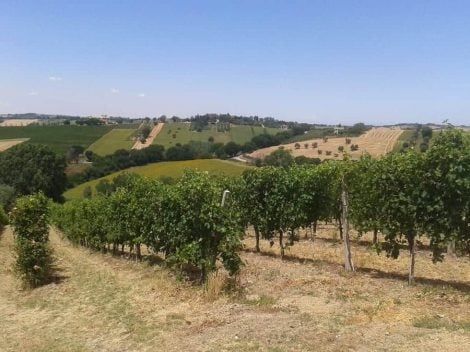We are in the Marche region, in the province of Ancona, where the small town of Morro d'Alba guards a little treasure, the native black grape variety Lacrima di Morro d'Alba. A grape so indissolubly linked to the territory that it even takes its name from it. The term "lacrima" (teardrop) derives from the peculiarity of the berries, which tend to break during ripening, releasing small drops of juice. Some genetic research suggests its relationship with the Aleatico, an ancient semi-aromatic grape variety widespread especially in the central and southern regions of Italy.
The origins of Lacrima di Morro d'Alba are very ancient; it is said that it was even the favorite wine of Federico Barbarossa when, during the siege of Ancona, he took possession of the castle of Morro d'Alba. At that time, the grape variety was widespread in the Marche region, in Romagna, Tuscany, Umbria, Campania, and along the Adriatic coast as far as Puglia. But over the centuries, it has been progressively uprooted and replaced with other varieties. The risk of extinction was averted only thanks to the forward-thinking work of some winemakers in the province of Ancona, the original cradle of the grape variety. In 1985, the recognition of the DOC sanctioned its importance within the Italian ampelographic panorama, decreeing its rebirth and renewed interest. Today, the denomination includes territories of the municipalities of Morro d'Alba, Belvedere Ostrense, Monte San Vito, Ostra, San Marcello, and Senigallia, all in the province of Ancona.
Lacrima di Morro d'Alba is a grape variety difficult to cultivate and sensitive to pests. These characteristics have certainly contributed to its progressive abandonment in favor of more resistant and productive varieties. It prefers hilly and well-ventilated exposures with clayey soils, rich in minerals. In the past, it was often cultivated according to the ancient custom of training the vine married to trees. A tradition that has now given way to more modern and rational training systems. Its clusters are of medium size; the berries have a dark blue color, with a thick skin but so delicate that it easily breaks during ripening, giving rise to the characteristic tearing.

The wine has an intense red color with violet reflections. The olfactory profile is delicately aromatic, with youthful vinous hints that evolve towards a floral bouquet, with notes of violet and perfumes of small red fruits. On the palate, it is fruity, harmonious, with soft tannins, persuasive, and good freshness. Precisely because of the characteristics of its aromas, it is preferred to refine it in steel, which preserves all the fragrance of the perfumes.
Lacrima di Morro d'Alba pairs very well with local cured meats, first courses with meat ragout, or second courses of white meats. Due to its delicacy and velvety tannins, it also pairs perfectly with the classic Anconetan fish stew.
The Best Lacrima di Morro d'Alba
Here are the best Lacrima di Morro d'Alba according to Gambero Rosso, which this year received the Due Bicchieri Rossi, having reached the final during the tastings for the Gambero Rosso 2024 Wine Guide, or the Due Bicchieri.
L'Orgiolo 2021 has slightly overripe fruity aromas and toasted echoes; the palate is round, with a smooth and compact impact, with a tight tannic structure. Lorenzo Marotti Campi has been involved since the beginning, in 1999, in the family business. Over the years, it has become a true beacon in the small Lacrima denomination: the uninterrupted work of exchanging ideas and experience with the cellarman Ivano Belardinelli and the winemaker Roberto Potentini, both with Lorenzo from the beginning, has yielded excellent results in terms of expression. But the company also knows its stuff when it comes to Verdicchio vinification, the other dominant variety in the area, declined in several well-differentiated interpretations.
Il Compagnia 2020 is a Lacrima matured in small French oak barrels that offers a floral and spicy olfactory profile of seductive intensity and a dense mouth, well marked from a tannic point of view, with a structure capable of challenging time. Claudio Gabellini's company had already been noticed in the past for its good versions of Lacrima and Verdicchio, the former obtained from vineyards surrounding the extensive and well-equipped cellar built at the beginning of the century, the latter from the vineyard with a single body located in Arcevia, on fresh soils just outside the classic area. After a few years, Umberto Trombelli, a Tuscan technician who knows the Marche reality well, returns to lead the technical team, and the wines regain good rigor and varietal adherence.
- Lacrima di Morro d'Alba 2022 - Conti di Buscareto
- Lacrima di Morro d'Alba Sup. Compagnia 2020 - Conti di Buscareto
Thirty years have passed since the foundation of the cellar by Nazzareno Vicari. And since then, many vines of Verdicchio and black lacrima have been planted in the increasing number of hectares developed around the original nucleus. Vico and Valentina, from children, have become adults and now lead the team of consultants who are responsible for transforming the grapes into wines with a modern touch, with a style characterized by ripeness, palate thickness, fragrance, and aromatic intensity. In the cellar, only steel is used to enhance the strength of the aromatic precursors of the grapes.
- Lacrima di Morro d'Alba Dasempre del Pozzo Buono 2022 - Vicari
- Lacrima di Morro d'Alba Sup. Lacrima del Pozzo Buono 2020 - Vicari
Lacrima di Morro D'Alba Joy 2022 from Tenuta di Frà is one of the wines produced by Franziska Waldner's company and her family. In love with the Marche, they decided to become producers by purchasing a company in Morro d'Alba. Gianluca Bartolucci and the winemaker Pierluigi Lorenzetti are responsible for managing the almost ten hectares, mostly planted with Verdicchio and Lacrima, with a few rows of Montepulciano and Bordeaux varieties. The panoramic and well-equipped cellar has everything you need to create a brilliant range, with a modern territoriality.
Le Cantarelle 2020 is a Lacrima matured in wood with a tenacious and complex development. The company of the Balducci family returns to our Vini d'Italia guide after several years, and we also highlight the selection of Verdicchio Gianni Balducci 2021 with an agile and dynamic profile, reminiscent of yellow citrus and almonds.
Some restlessness in Paolo Lucchetti's wines: Mariasole 2020, made from withered grapes, has a deliberately unconventional originality; Vittoria 2021 gives vegetal sensations and a consistent sip, typically bitter.


 Wine promotion, vineyard uprooting, and support for dealcoholised wines: the European Commission's historic compromise on viticulture
Wine promotion, vineyard uprooting, and support for dealcoholised wines: the European Commission's historic compromise on viticulture A small Sicilian farmer with 40 cows wins silver at the World Cheese Awards
A small Sicilian farmer with 40 cows wins silver at the World Cheese Awards Women are the best sommeliers. Here are the scientific studies
Women are the best sommeliers. Here are the scientific studies Where to eat at a farm stay in Sicily: the best addresses in the Provinces of Trapani, Palermo, and Agrigento
Where to eat at a farm stay in Sicily: the best addresses in the Provinces of Trapani, Palermo, and Agrigento Wine in cans, bottle-fermented, and alcohol free: the unstoppable change in Gen Z’s tastes
Wine in cans, bottle-fermented, and alcohol free: the unstoppable change in Gen Z’s tastes






